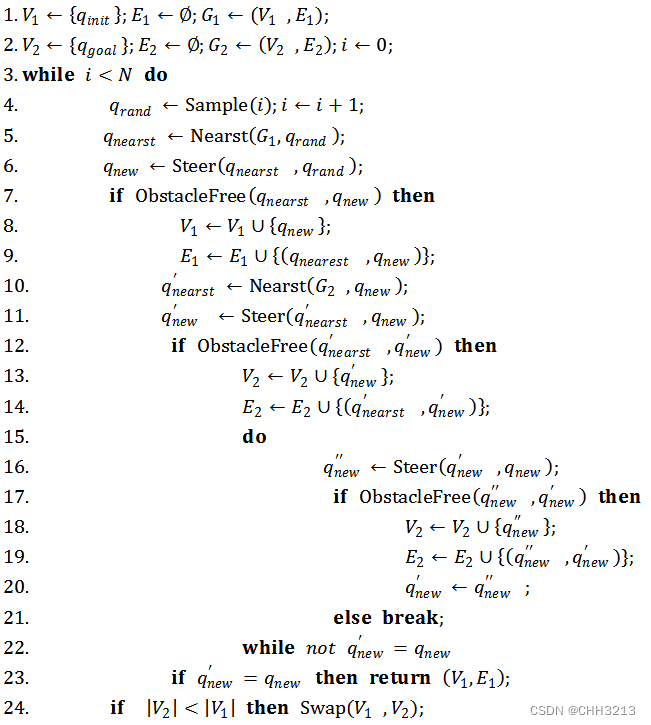【自动驾驶】基于采样的路径规划算法——RRT-Connect(含python实现 | c++实现)
前文回顾基于采样的路径规划算法——RRT(含python实现)基于随机采样的路径规划算法适用于高维度空间,它们以概率完备性(当时间接近无限时一定有解)来代替完备性,从而提高搜索效率。基于随机采样的路径规划算法又分为单查询算法(single-query path planning)以及渐近最优算法(asymptotically optimal path planning),前者只要找到可行路径即可,
参考资料
前文回顾
1. 基本概念
1.1 基于随机采样的路径规划算法
-
基于随机采样的路径规划算法适用于高维度空间,它们以概率完备性(当时间接近无限时一定有解)来代替完备性,从而提高搜索效率。
-
基于随机采样的路径规划算法又分为单查询算法(single-query path planning)以及渐近最优算法(asymptotically optimal path planning),前者只要找到可行路径即可,侧重快速性,后者还会对找到的路径进行逐步优化,慢慢达到最优,侧重最优性。单查询方法包括概率路图算法(Probabilistic Road Map, PRM)、快速随机扩展树算法(Rapidly-exploring Random Tree, RRT)、RRT-Connect算法等,渐近最优算法有RRT*算法等。
1.2 RRT-Connect
在前文讲述了RRT及其python代码实现。现在进一步地在RRT的基础上引入RRT的改进版本RRT-Connect。
- RRT-Connect算法在RRT的基础上引入了双树扩展环节,分别以起点和目标点为根节点同时扩展随机树从而实现对状态空间的快速搜索。
- 当两棵树建立连接时可认为路径规划成功。
- 通过一次采样得到一个采样点 q r a n d q_{rand} qrand ,然后两棵搜索树同时向采样点方向进行扩展,加快两棵树建立连接的速度。相较于单树扩展的RRT算法,RRT-Connect加入了启发式步骤,加快了搜索速度,对于狭窄通道也具有较好的效果。
1.3 算法伪代码

- 每一次迭代中,开始步骤与原始的RRT算法一样,都是采样随机点然后进行扩展。
- 然后扩展完第一棵树的新节点 𝑞 𝑛 𝑒 𝑤 𝑞_{𝑛𝑒𝑤} qnew后,以这个新的目标点 𝑞 𝑛 𝑒 𝑤 𝑞_{𝑛𝑒𝑤} qnew作为第二棵树扩展的方向得到 𝑞 𝑛 𝑒 𝑤 ′ 𝑞'_{𝑛𝑒𝑤} qnew′。
- 同时第二棵树扩展的方式略有不同(15~22行),首先它会扩展固定步长得到 𝑞 𝑛 𝑒 𝑤 ′ ′ 𝑞''_{𝑛𝑒𝑤} qnew′′,如果没有碰撞,继续往相同的方向扩展第二步,直到扩展失败或者 𝑞 ′ 𝑛 𝑒 𝑤 = 𝑞 𝑛 𝑒 𝑤 𝑞′_{𝑛𝑒𝑤}=𝑞_{𝑛𝑒𝑤} q′new=qnew表示与第一棵树相连了,即connect了,整个算法结束。
- 每次迭代中必须考虑两棵树的平衡性,即两棵树的节点数的多少(也可以考虑两棵树总共花费的路径长度),交换次序选择“小”的那棵树进行扩展。
1.4 RRT-Connect的特点
这种双向的RRT技术具有良好的搜索特性,比原始RRT算法的搜索速度、搜索效率有了显著提高。
- 首先,Connect算法较之前的算法在扩展的步长上更长,使得树的生长更快;
- 其次,两棵树不断朝向对方交替扩展,而不是采用随机扩展的方式,特别当起始位姿和目标位姿处于约束区域时,两棵树可以通过朝向对方快速扩展而逃离各自的约束区域。
- 这种带有启发性的扩展使得树的扩展更加贪婪和明确,使得双树RRT算法较之单树RRT算法更加有效。
RRT-Connect和RRT一样,都是单查询算法,最终路径并不是最优的。
2. python代码实现
RRT-Connect算法与基础的RRT算法差别不大,因此我直接根据RRT-Connect的伪代码对RRT算法代码进行修改,得到的RRT-Connect算法的python实现如下:
import math
import random
import matplotlib.pyplot as plt
import numpy as np
from celluloid import Camera # 保存动图时用,pip install celluloid
import operator
import copy
class RRT_Connect:
"""
Class for RRT_Connect planning
"""
class Node:
"""
创建节点
"""
def __init__(self, x, y):
self.x = x # 节点坐标
self.y = y
self.path_x = [] # 路径,作为画图的数据,也可以理解成保存的边集
self.path_y = []
self.parent = None #父节点
class AreaBounds:
"""区域大小
"""
def __init__(self, area):
self.xmin = float(area[0])
self.xmax = float(area[1])
self.ymin = float(area[2])
self.ymax = float(area[3])
def __init__(self,
start,
goal,
obstacle_list,
rand_area,
expand_dis=3.0,
goal_sample_rate=5,
max_iter=1000,
play_area=None,
robot_radius=0.0,
):
"""
Setting Parameter
start:起点 [x,y]
goal:目标点 [x,y]
obstacleList:障碍物位置列表 [[x,y,size],...]
rand_area: 采样区域 x,y ∈ [min,max]
play_area: 约束随机树的范围 [xmin,xmax,ymin,ymax]
robot_radius: 机器人半径
expand_dis: 扩展的步长
goal_sample_rate: 采样目标点的概率,百分制.default: 5,即表示5%的概率直接采样目标点
"""
self.start = self.Node(start[0], start[1]) # 根节点
self.end = self.Node(goal[0], goal[1])
self.min_rand = rand_area[0]
self.max_rand = rand_area[1]
if play_area is not None:
self.play_area = self.AreaBounds(play_area)
else:
self.play_area = None
self.expand_dis = expand_dis
self.goal_sample_rate = goal_sample_rate
self.max_iter = max_iter
self.obstacle_list = obstacle_list
self.node_list_1 = []
self.node_list_2 = []
self.robot_radius = robot_radius
def planning(self, animation=True,camara=None):
"""
rrt path planning
animation: flag for animation on or off
camara: 是否保存动图
"""
# 将起点作为根节点x_{init},加入到随机树的节点集合中。
self.node_list_1 = [self.start]
self.node_list_2 = [self.end]
for i in range(self.max_iter):
# 从可行区域内随机选取一个节点q_{rand}
rnd_node = self.sample_free()
# 已生成的树中利用欧氏距离判断距离q_{rand}最近的点q_{near}。
nearest_ind_1 = self.get_nearest_node_index(self.node_list_1, rnd_node)
nearest_node_1 = self.node_list_1[nearest_ind_1]
# 从q_{near}与q_{rand}的连线方向上扩展固定步长u,得到新节点 q_{new}
new_node_1 = self.steer(nearest_node_1, rnd_node, self.expand_dis)
# 第一棵树,如果在可行区域内,且q_{near}与q_{new}之间无障碍物
if self.is_inside_play_area(new_node_1, self.play_area) and self.obstacle_free(new_node_1, self.obstacle_list, self.robot_radius):
self.node_list_1.append(new_node_1)
# 扩展完第一棵树的新节点$x_{𝑛𝑒𝑤}$后,以这个新的目标点$x_{𝑛𝑒𝑤}$作为第二棵树扩展的方向。
nearest_ind_2 = self.get_nearest_node_index(self.node_list_2, new_node_1)
nearest_node_2 = self.node_list_2[nearest_ind_2]
new_node_2 = self.steer(nearest_node_2, new_node_1, self.expand_dis)
# 第二棵树
if self.is_inside_play_area(new_node_2, self.play_area) and self.obstacle_free(new_node_2, self.obstacle_list, self.robot_radius):
self.node_list_2.append(new_node_2)
while True:
new_node_2_ = self.steer(new_node_2, new_node_1, self.expand_dis)
if self.obstacle_free(new_node_2_, self.obstacle_list, self.robot_radius):
self.node_list_2.append(new_node_2_)
new_node_2 = new_node_2_
else:
break
# print([new_node_2.x,new_node_2.y], [new_node_1.x,new_node_1.y])
# 当$𝑞′_{𝑛𝑒𝑤}=𝑞_{𝑛𝑒𝑤}$时,表示与第一棵树相连,算法结束
if operator.eq([new_node_2.x,new_node_2.y], [new_node_1.x,new_node_1.y]):
return self.generate_final_path()
# 考虑两棵树的平衡性,即两棵树的节点数的多少,交换次序选择“小”的那棵树进行扩展。
# 不过不交换的情况下好像搜索速度还更快
if len(self.node_list_1)>len(self.node_list_2):
list_tmp = copy.deepcopy(self.node_list_1)
self.node_list_1 = copy.deepcopy(self.node_list_2)
self.node_list_2 = list_tmp
if animation and i % 5 ==0:
self.draw_graph(rnd_node,new_node_1, camara)
return None # cannot find path
def steer(self, from_node, to_node, extend_length=float("inf")):
"""连线方向扩展固定步长查找x_new
Args:
from_node (_type_): x_near
to_node (_type_): x_rand
extend_length (_type_, optional): 扩展步长u. Defaults to float("inf").
Returns:
_type_: _description_
"""
# 利用反正切计算角度, 然后利用角度和步长计算新坐标
d, theta = self.calc_distance_and_angle(from_node, to_node)
# 如果$q_{near}$与$q_{rand}$间的距离小于步长,则直接将$q_{rand}$作为新节点$q_{new}$
if extend_length >= d:
new_x = to_node.x
new_y = to_node.y
else:
new_x = from_node.x+math.cos(theta)
new_y = from_node.y+math.sin(theta)
new_node_1 = self.Node(new_x,new_y)
new_node_1.path_x = [from_node.x] # 边集
new_node_1.path_y = [from_node.y]
new_node_1.path_x.append(new_x)
new_node_1.path_y.append(new_y)
new_node_1.parent = from_node
return new_node_1
def generate_final_path(self):
"""生成路径
Args:
Returns:
_type_: _description_
"""
path_1 = []
node = self.node_list_1[-1]
while node.parent is not None:
path_1.append([node.x, node.y])
node = node.parent
path_1.append([node.x, node.y])
path_2 = []
node = self.node_list_2[-1]
while node.parent is not None:
path_2.append([node.x, node.y])
node = node.parent
path_2.append([node.x, node.y])
path=[]
for i in range(len(path_1)-1,-1,-1):
path.append(path_1[i])
for i in range(len(path_2)):
path.append(path_2[i])
return path
def calc_dist(self, x1, y1,x2,y2):
"""计算距离
"""
dx = x1 - x2
dy = y1 - y2
return math.hypot(dx, dy)
def sample_free(self):
# 以(100-goal_sample_rate)%的概率随机生长,(goal_sample_rate)%的概率朝向目标点生长
if random.randint(0, 100) > self.goal_sample_rate:
rnd = self.Node(
random.uniform(self.min_rand, self.max_rand),
random.uniform(self.min_rand, self.max_rand))
else: # goal point sampling
rnd = self.Node(self.end.x, self.end.y)
return rnd
def draw_graph(self, rnd=None,rnd_2=None, camera=None):
if camera==None:
plt.clf()
# for stopping simulation with the esc key.
plt.gcf().canvas.mpl_connect(
'key_release_event',
lambda event: [exit(0) if event.key == 'escape' else None])
# 画随机点
if rnd is not None:
plt.plot(rnd.x, rnd.y, "^k")
if self.robot_radius > 0.0:
self.plot_circle(rnd.x, rnd.y, self.robot_radius, '-r')
if rnd_2 is not None:
plt.plot(rnd_2.x, rnd_2.y, "^r")
if self.robot_radius > 0.0:
self.plot_circle(rnd_2.x, rnd_2.y, self.robot_radius, '-b')
# 画已生成的树
for node in self.node_list_1:
if node.parent:
plt.plot(node.path_x, node.path_y, "-g")
for node in self.node_list_2:
if node.parent:
plt.plot(node.path_x, node.path_y, "-g")
# 画障碍物
for (ox, oy, size) in self.obstacle_list:
self.plot_circle(ox, oy, size)
# 如果约定了可行区域,则画出可行区域
if self.play_area is not None:
plt.plot([self.play_area.xmin, self.play_area.xmax,
self.play_area.xmax, self.play_area.xmin,
self.play_area.xmin],
[self.play_area.ymin, self.play_area.ymin,
self.play_area.ymax, self.play_area.ymax,
self.play_area.ymin],
"-k")
# 画出起点和目标点
plt.plot(self.start.x, self.start.y, "xr")
plt.plot(self.end.x, self.end.y, "xr")
plt.axis("equal")
plt.axis([-2, 15, -2, 15])
plt.grid(True)
plt.pause(0.01)
if camera!=None:
camera.snap()
# 静态方法无需实例化,也可以实例化后调用,静态方法内部不能调用self.的变量
@staticmethod
def plot_circle(x, y, size, color="-b"): # pragma: no cover
deg = list(range(0, 360, 5))
deg.append(0)
xl = [x + size * math.cos(np.deg2rad(d)) for d in deg]
yl = [y + size * math.sin(np.deg2rad(d)) for d in deg]
plt.plot(xl, yl, color)
@staticmethod
def get_nearest_node_index(node_list_1, rnd_node):
dlist = [(node.x - rnd_node.x)**2 + (node.y - rnd_node.y)**2
for node in node_list_1]
minind = dlist.index(min(dlist))
return minind
@staticmethod
def is_inside_play_area(node, play_area):
if play_area is None:
return True # no play_area was defined, every pos should be ok
if node.x < play_area.xmin or node.x > play_area.xmax or \
node.y < play_area.ymin or node.y > play_area.ymax:
return False # outside - bad
else:
return True # inside - ok
@staticmethod
def obstacle_free(node, obstacleList, robot_radius):
if node is None:
return False
for (ox, oy, size) in obstacleList:
dx_list = [ox - x for x in node.path_x]
dy_list = [oy - y for y in node.path_y]
d_list = [dx * dx + dy * dy for (dx, dy) in zip(dx_list, dy_list)]
if min(d_list) <= (size+robot_radius)**2:
return False # collision
return True # safe
@staticmethod
def calc_distance_and_angle(from_node, to_node):
"""计算两个节点间的距离和方位角
Args:
from_node (_type_): _description_
to_node (_type_): _description_
Returns:
_type_: _description_
"""
dx = to_node.x - from_node.x
dy = to_node.y - from_node.y
d = math.hypot(dx, dy)
theta = math.atan2(dy, dx)
return d, theta
def main(gx=6.0, gy=10.0):
print("start " + __file__)
fig = plt.figure(1)
camera = Camera(fig) # 保存动图时使用
camera = None # 不保存动图时,camara为None
show_animation = True
# ====Search Path with RRT_Connect====
obstacleList = [(3, 6, 1), (3, 8, 2), (3, 10, 2), (7, 5, 1),
(9, 5, 2), (8, 10, 1), (7, 5, 2), (10, 5, 2)] # [x, y, radius]
# Set Initial parameters
rrt = RRT_Connect(
start=[0, 0],
goal=[gx, gy],
rand_area=[-2, 15],
obstacle_list=obstacleList,
play_area=[0, 10, 0, 14],
robot_radius=0.8
)
path = rrt.planning(animation=show_animation,camara=camera)
if path is None:
print("Cannot find path")
else:
path = np.array(path)
print(path)
print("found path!!")
# Draw final path
if show_animation:
rrt.draw_graph(camera=camera)
plt.grid(True)
plt.pause(0.01)
plt.plot(path[:,0], path[:,1], '-r')
if camera!=None:
camera.snap()
animation = camera.animate()
animation.save('trajectory.gif')
plt.figure(2)
plt.axis("equal")
plt.axis([-2, 15, -2, 15])
plt.grid(True)
plt.plot(path[:,0], path[:,1], '-r')
plt.show()
if __name__ == '__main__':
main()
效果如下:

可见,RRT-Connect和RRT一样,都是单查询算法,最终路径并不是最优的。
所有算法代码均存于github仓库,欢迎访问。
3. c++实现
由于在自动驾驶中算法实现一般使用C++,所以我也使用C++实现了相关功能,代码结构与python代码实现类似,这边就不再做相关代码解释了。完整代码详见另一个github仓库。
更多推荐
 已为社区贡献1条内容
已为社区贡献1条内容









所有评论(0)